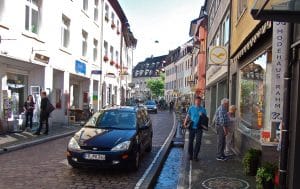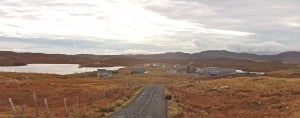If you’re looking for an enlightened place to be, they say you need look no further than Freiburg. Having heard all about the place at an RTPI Scotland annual Geddes lecture and blogged glowingly about it, it seemed only right to finally make a visit.
 Freiburg has a well-earned reputation for environmentalism, people-friendly streets and welcoming spaces. It’s known as a town that cares about design, sustainability and renewable energy. It’s a place where decision makers have taken decisions and got things done, rather than fudged and fumbled and left future administrations to deal with the consequences. We’ve been talking for decades about the possibilities of public sector-led advance infrastructure. They’ve been doing it for decades, including social facilities like schools and nurseries.
Freiburg has a well-earned reputation for environmentalism, people-friendly streets and welcoming spaces. It’s known as a town that cares about design, sustainability and renewable energy. It’s a place where decision makers have taken decisions and got things done, rather than fudged and fumbled and left future administrations to deal with the consequences. We’ve been talking for decades about the possibilities of public sector-led advance infrastructure. They’ve been doing it for decades, including social facilities like schools and nurseries.
It sounds so different to our typical experience at home. The strange thing is, at face value it doesn’t look that different – it’s just a town, albeit an attractive and highly functional one. It has streets and spaces, parks and shops, historic buildings and new ones. People go about their business. At first glance you might think it’s a lot like your own town.
Pretty soon, the differences dawn. A main street with a fully shared surface, filled by cyclists, pedestrians and what we would think of as deadly trams. There are few cars but to spice things up there are open water channels a foot wide and a foot deep weaving along the streets. The local population (and visitors) seem to avoid falling down these bächle – historic water supply and fire fighting features. Instead, kids sail boats in them, pull strings of colourful plastic ducks or paddle in them in summer. The trams and cyclists and pedestrians continue on their way. It’s a traffic engineer’s hell. A health and safety officer’s hell. A car driver’s hell.
 Elsewhere, a back lane of recycling workshops, themselves built from recycled huts, trailers, camper vans and buses is a hive of activity, employment and social exchange. It looks like a Jane Jacobs dream come true. A tax inspector’s hell. A building inspector’s hell. A planner’s hell. It works. You wouldn’t get away with it here….
Elsewhere, a back lane of recycling workshops, themselves built from recycled huts, trailers, camper vans and buses is a hive of activity, employment and social exchange. It looks like a Jane Jacobs dream come true. A tax inspector’s hell. A building inspector’s hell. A planner’s hell. It works. You wouldn’t get away with it here….
The housing neighbourhood we stayed in had a communal space – a simple courtyard with some seats, a few trees and loads of bicycle stands. It functions as a multipurpose local square for kids play, mini-markets, music events, local festivals, bike repair workshops, whatever, whenever. We have plenty similar spaces here, although many of them are a sop to open space standards. It takes more than the space to make this activity happen. It’s a state of mind.
That state of mind may come from confidence amongst those who live in and visit Freiburg that this is a town where quality of life matters. It’s a place where many people seem to feel like they have a share in the vision and a personal responsibility to deliver. It’s what the drive for community empowerment in Scotland is all about.
Then again, many people we met seemed happy just to get on with their lives, as if this really was just another town. And like any other place, there’s still dissatisfaction with politicians, public servants and private interests. Some things are the same everywhere.
But still, some things are different.
Archive | community
Land Reform In One Easy SLUP
 We’re working with Falkland Estate in Fife – home of the Centre for Stewardship – on estate visioning and master planning. Today we helped host a visit from the Scottish Government’s Rural Affairs, Climate Change and Environment committee (RACCE). The visit was part of the committee’s land reform fact-finding tour, which is working its way around the country. In a brief presentation, we explained the importance of long term spatial planning and visioning for estates and large land holdings or sites.
We’re working with Falkland Estate in Fife – home of the Centre for Stewardship – on estate visioning and master planning. Today we helped host a visit from the Scottish Government’s Rural Affairs, Climate Change and Environment committee (RACCE). The visit was part of the committee’s land reform fact-finding tour, which is working its way around the country. In a brief presentation, we explained the importance of long term spatial planning and visioning for estates and large land holdings or sites.
At Falkland, we’re effectively merging the PAN 83 urban master planning model we’ve applied for private estates at Bowmore, Inveraray and Forres recently, with the feasibility model for community land ownership studies at Culbokie, Lochmaddy and Great Bernera (working with Dr Calum MacLeod’s team).
The aim is to facilitate sustainable land management. The model works for both private and community land ownership. It’s as good an indication as any that the landowner is committed to sustainable use of the land.
These days, there’s a statutory requirement for major planning applications to be accompanied by a Design Statement (see PAN 68). Quality of place is a high priority for the Scottish Government, with cross-party support. The requirement for a Design Statement reflects this. It’s still disappointing that many Design Statements are accepted by planning authorities despite being half-hearted box-ticking exercises, but that’s another blog….
Like quality of place, the Scottish Government has made land reform a priority. Again, there’s broad cross-party support (with the exception of the Conservatives, who take a more cautious position). One aspect of the current Land Reform (Scotland) Bill 2015, is the contentious matter of sustainable land use and the potential for communities to be granted rights to purchase land which is not being used sustainably.
At this stage, it’s unclear what that means. What mechanisms might the Scottish Government apply to define sustainable land use? How might land owners illustrate a commitment to sustainable use? If a Design Statement proves a commitment to quality place making, could an estate master plan or vision do the same for sustainable land use?
We think so.
A document similar to PAN 68 could set out advice on preparing a Sustainable Land Use Plan (SLUP!) and encourage land owners to follow best practice and prepare their own. The forthcoming Land Reform (Scotland) Act could explain the scenarios where the proposed Scottish Land Commission might request a SLUP as evidence of effective land management.
There’s an obvious resource issue in rolling out this kind of study but our experience suggests that it proves cost effective by unearthing investment opportunities, financial efficiencies and greatly enhanced relationships with stakeholders and communities. That applies to land in private or community ownership.
Land reform may be a polarising issue, but most people seem to agree that sustainable land use is a valid ambition. A tool like SLUP can add value across the spectrum. Why wouldn’t we use it?
